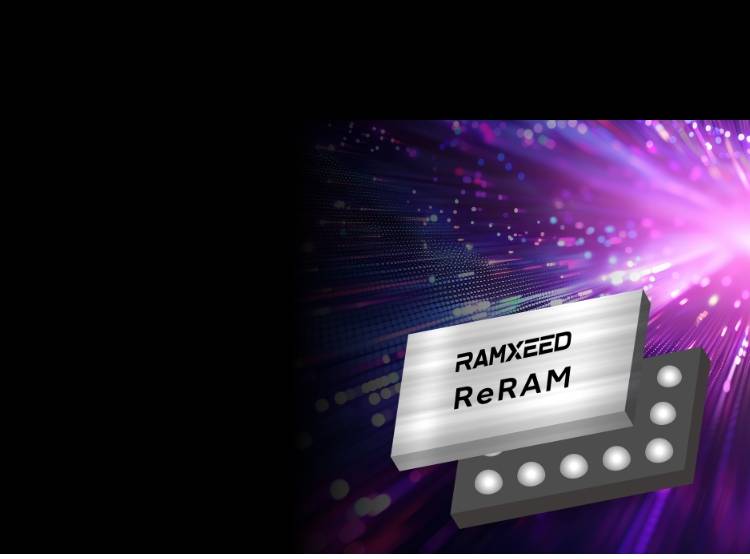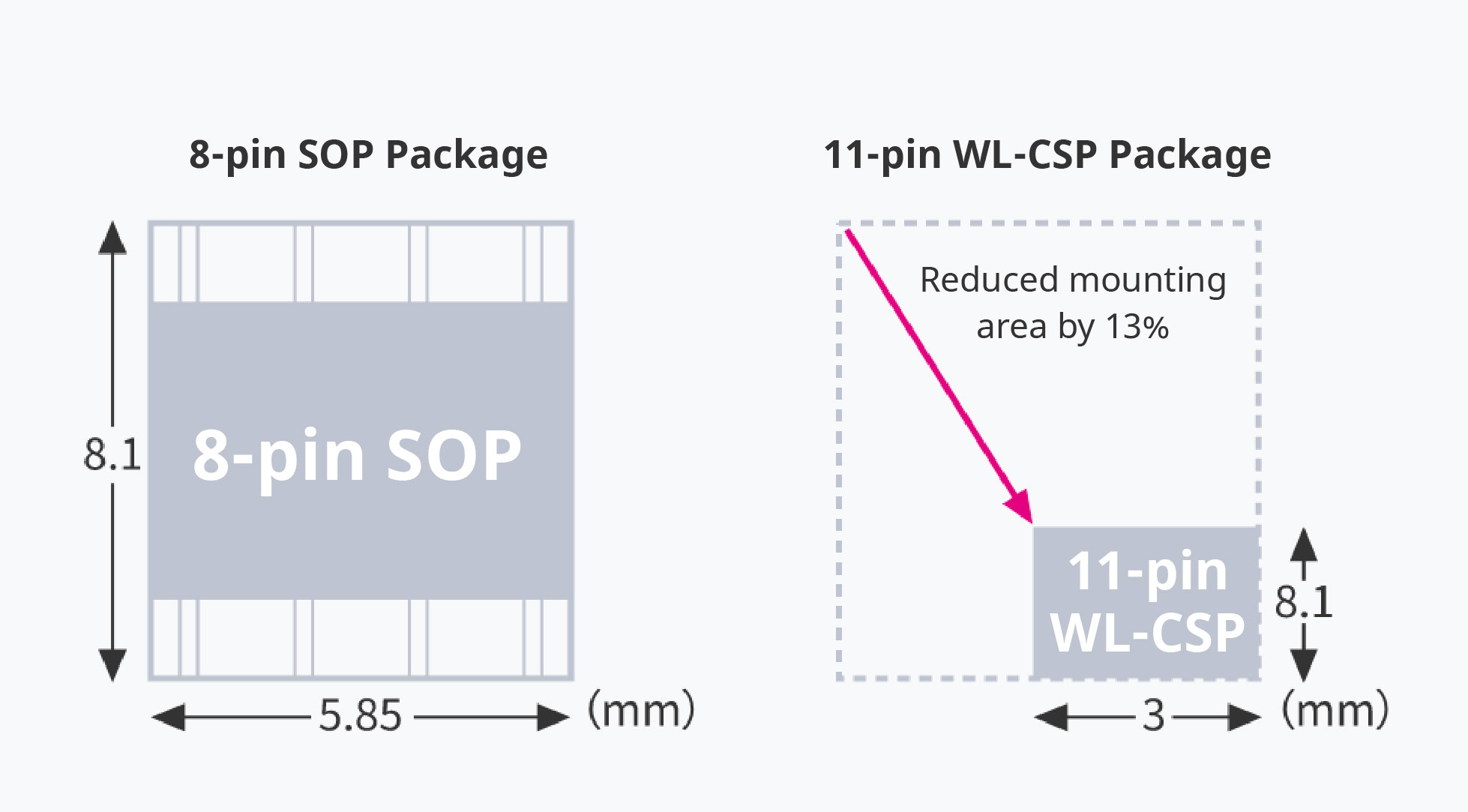

Reasons to Choose ReRAM
Introducing ReRAM (Resistive RAM)
RAMXEED offers two types of non-volatile memory: FeRAM and ReRAM. Since the two types have different characteristics, they are specialized toward different applications. The main advantage of ReRAM is that the operating current during read operations is very small. Since the number of data read operations is unlimited, ReRAM is suitable for applications with high program read frequency.
Since the current during read operations is very small, it can also be expected to extend the battery life of small battery-powered devices. For example, it is ideal for small wearable devices such as hearing aids and smartwatches. On the other hand, the advantage of FeRAM is that it guarantees a large number of data rewrites. Because it allows data to be rewritten up to 100 trillion times, FeRAM is suitable for applications where data is continuously written in real time. For example, it is used as memory to record information in meters, industrial robots, and automobiles.
Features of ReRAM and FeRAM
| ReRAM | FeRAM |
|---|---|
|
Non-volatile
|
Non-volatile
|
|
Low read
|
High read/write cycle
|
|
Large capacity
|
Fast write speed
|
|
Ultra-compact
|
Low power consumption
|
| FeRAM |
|---|
|
Non-volatile
|
|
High read/write cycle
|
|
Fast write speed
|
|
Low power consumption
|
Positioning of non-volatile memory types


1.Features of ReRAM
ReRAM has four key features: non-volatility, low read current, high capacity, and ultra-compact package.
| Non-volatile |
|
|---|---|
| Low read |
|
| Large capacity |
|
| Ultra-compact |
|
The table below shows a comparison of features with existing memory products. The three general-purpose memories listed here—EEPROM, flash memory, and SRAM—are all types of memory that can be easily replaced with ReRAM. The table shows that ReRAM has a low read and write current compared to other types of memory. The operating power supply voltage is also from as low as 1.6V, enabling low power consumption during operation. In addition, compared with SRAM, which requires a battery to retain data when the power is turned off, ReRAM—which is non-volatile memory—does not require a battery, making it an easy-to-use memory type. For these reasons, since ReRAM can be said to have low power consumption during operation, we can also say that it is advantageous memory type in terms of low power consumption.
Comparison of features with general-purpose memory


| Item | ReRAM | EEPROM | Flash memory | SRAM |
|---|---|---|---|---|
| Memory type | Non-volatile | Non-volatile | Non-volatile | Volatile |
| Data retention battery | Not required | Not required | Not required | Not required |
| Read current | 0.15mA (@5MHz) |
0.15mA (@5MHz) |
4mA (@33MHz) |
20mA (@55ns) |
| Write current | 1.5mA | 3mA | 15mA | 20mA (@55ns) |
| Read cycles | Unlimited | Unlimited | Unlimited | Unlimited |
| Write cycles | 1 million times | 1 million times | 100,000 times. | Unlimited |
| Power supply voltage (minimum) | 1.6V〜 | 1.8V〜 | 2.7V〜 | 2.7V〜 |
 High capacity and compact package
High capacity and compact package
The package of our ReRAM products is a WL-CSP (Wafer Level Chip Size Package) with dimensions of 2mm x 3mm (6mm²). While the 8-pin SOPs found in many non-volatile memory SPI interfaces have legs (leads) extruding from the package, the WL-CSP has contact balls on the backside, reducing its mounting area footprint. For example, when compared to 4Mbit 8-pin SOP memory, the 12Mbit ReRAM has triple the memory density with over an 80% reduction in footprint size.
SOP and WL-CSP mounting area comparison

ReRAM pin layout and dimensions
(8Mbit and 12Mbit products are the same)

 Low read current
Low read current
The average ReRAM read current is 0.15mA at 5MHz. This is around 95% lower than the average EEPROM read current of 3.0mA at the same 5MHz operating frequency. This feature makes it ideal for wearable devices that run on batteries. Specifically, in hearing aids, initial setup (parameter) data is recorded, and the data is then frequently accessed and used (by data read operation) when the device is in use. In such applications, a low read current can reduce battery consumption. Among battery-powered electrical products, it can be said that our ReRAM is particularly suitable for applications in wearable devices which require a small memory package size and where data is read frequently.
Read current comparison

2.Customer issues and solutions with ReRAM
If you have any of the following issues, you may be able to solve them by replacing existing memory with our ReRAM memory.
We are currently using EEPROM, but there is no high-capacity lineup. Replacement with flash memory is difficult because it would require a software update.

Our ReRAM products have capacity of up to 12Mbit. It is easy to replace EEPROM with ReRAM, since there is no need for erase operations or sector-by-sector writing.
We want to increase memory density, but the package size cannot be increased because the available mounting space is limited.

We can supply 8Mbit and 12Mbit products in a small package with dimensions of 2mm x 3mm. Even if you are using 8Mbit ReRAM, you can replace it with 12Mbit ReRAM with the same pin layout and package size.
We want to reduce power consumption, but it is difficult to significantly reduce it with conventional non-volatile memory.

The read current of ReRAM is less than 10% that of other non-volatile memory such as EEPROM, and the power supply voltage is 1.6V, enabling a reduction in power consumption.
Since our product has a small battery, not only average current consumption but also peak current is a concern.

ReRAM also has low peak current, making it suitable for use with small batteries.
